 W
WLunch meats—also known as cold cuts, luncheon meats, cooked meats, sliced meats, cold meats, and deli meats—are precooked or cured meats that are sliced and served cold or hot. They are typically served in sandwiches or on a tray. They can be purchased pre-sliced, usually in vacuum packs, or they can be sliced to order.
 W
WBayonne ham or jambon de Bayonne is a cured ham that takes its name from the ancient port city of Bayonne in the far southwest of France, a city located in both the cultural regions of Basque Country and Gascony. It has PGI status.
 W
WBlood Tongue, or Zungenwurst, is a variety of German head cheese with blood. It is a large head cheese that is made with pig's blood, suet, bread crumbs and oatmeal with chunks of pickled beef tongue added. It has a slight resemblance to blood sausage. It is commonly sliced and browned in butter or bacon fat prior to consumption. It is sold in markets pre-cooked and its appearance is maroon to black in color.
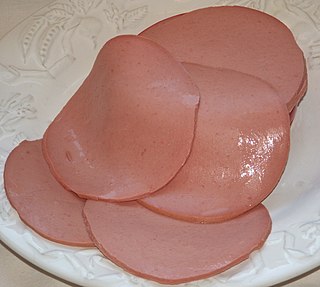 W
WBologna sausage, also called baloney or parizer, is a sausage derived from mortadella, a similar-looking, finely ground pork sausage containing cubes of pork fat, originally from the Italian city of Bologna. Other common names include polony in Zimbabwe, Zambia and South Africa, devon in most states of Australia, and fritz in South Australia. Typical seasoning for bologna includes black pepper, nutmeg, allspice, celery seed and coriander and, like mortadella, myrtle berries give it its distinctive flavor. U.S. government regulations require American bologna to be finely ground and without visible pieces of fat. Aside from pork, bologna can be made out of chicken, turkey, beef, venison, a combination or soy protein.
 W
WBraunschweiger is a type of sausage. The type of sausage the term refers to varies by region. In the German language, Braunschweiger is the demonym for people from Brunswick, but under German food law refers to a variety of mettwurst. In Austria, Braunschweiger is known as a type of parboiled sausage (Brühwurst), while American Braunschweiger is often confused with liverwurst.
 W
WCapocollo, coppa, gabagool, or capicola is a traditional Italian and Corsican pork cold cut (salume) made from the dry-cured muscle running from the neck to the fourth or fifth rib of the pork shoulder or neck. It is a whole-muscle salume, dry cured, and typically sliced very thinly. It is similar to the more widely known cured ham or prosciutto, because they are both pork-derived cold-cuts used in similar dishes. It is not brined as ham typically is.
 W
WCharcuterie is a French term for a branch of cooking devoted to prepared meat products, such as bacon, ham, sausage, terrines, galantines, ballotines, pâtés, and confit, primarily from pork.
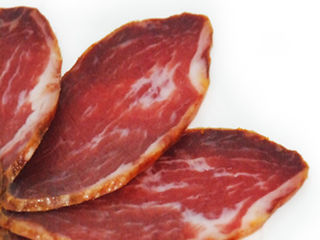 W
WCured pork tenderloin is found in various cuisines in Mediterranean Europe and South America. It is typically salted or brined then dry-cured or smoked.
 W
WDevon is a type of manufactured meat product sold in Australia and New Zealand. It is referred to as "polony" in Western Australia, "luncheon sausage" in northern areas of New Zealand, "fritz" in South Australia, "Belgium" and "devon" in Victoria, Tasmania, Queensland, New South Wales and the Australian Capital Territory, and "Belgium" in southern areas of New Zealand. It is also referred to as "Windsor sausage" in Queensland. Devon would be classed as "luncheon meat" in the UK. Certainly in Queensland, Australia- you can find both 'Luncheon' and 'Devon' for sale at some retailers, with each having a slightly different appearance and price-point. Originally known in some parts of Australia as "German sausage", this name fell out of favour during World War I when Australia was at war with Germany. 'Veal German' is another facsimile. It is similar in appearance and taste to the bologna sausage and the cooked pork sausage known in Australia as Berliner. It is considered to be a cheap meat product.
 W
WFenalår is a traditional Norwegian cured meat made from salted and dried leg of lamb. Fenalår is a very popular dish in Norway and is often served with other preserved food at a Christmas buffet or at Norwegian Constitution Day.
 W
WFinocchiona is a salami variety, typical of Tuscany, Florence area. It is characterized for the use of fennel.
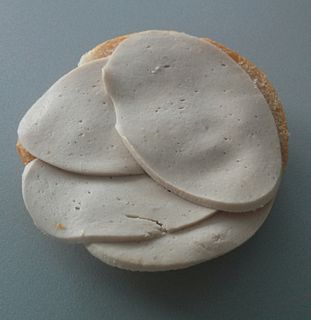 W
WGelbwurst, meaning “yellow sausage”, is a traditional sausage from Bavaria, Germany.
 W
WHam is pork from a leg cut that has been preserved by wet or dry curing, with or without smoking. As a processed meat, the term "ham" includes both whole cuts of meat and ones that have been mechanically formed.
 W
WHead cheese or brawn is a cold cut that is a terrine or meat jelly often made with flesh from the head of a calf or pig, or less commonly a sheep or cow, and often set in aspic that originated in Europe; it is not a dairy cheese. A version pickled with vinegar is known as souse. The parts of the head used vary, but the brain, eyes, and ears are usually removed. The tongue, and sometimes the feet and heart, may be included. It can also be made from trimmings from pork and veal, adding gelatin to the stock as a binder. Sometimes, it is made with nothing from the head.
 W
WHead cheese or brawn is a cold cut that is a terrine or meat jelly often made with flesh from the head of a calf or pig, or less commonly a sheep or cow, and often set in aspic that originated in Europe; it is not a dairy cheese. A version pickled with vinegar is known as souse. The parts of the head used vary, but the brain, eyes, and ears are usually removed. The tongue, and sometimes the feet and heart, may be included. It can also be made from trimmings from pork and veal, adding gelatin to the stock as a binder. Sometimes, it is made with nothing from the head.
 W
WKielbasa is any type of meat sausage from Poland, and a staple of Polish cuisine. In American English the word typically refers to a coarse, U-shaped smoked sausage of any kind of meat, which closely resembles the Wiejska sausage in British English.
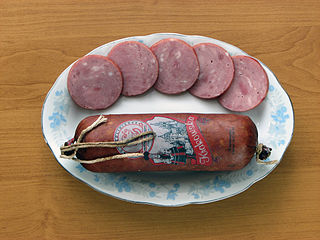 W
WKrakowska is a type of Polish sausage (kielbasa), usually served as a cold cut. The name derives from the city of Kraków. It is made from cuts of lean pork seasoned with pepper, allspice, coriander, and garlic, packed into large casings, and smoked.
 W
WLardo is a type of salumi made by curing strips of fatback with rosemary and other herbs and spices.
 W
WMontreal-style smoked meat, Montreal smoked meat or simply smoked meat in Canada is a type of kosher-style deli meat product made by salting and curing beef brisket with spices. The brisket is allowed to absorb the flavours over a week, is then hot smoked to cook through, and finally is steamed to completion. This is a variation on corned beef and is similar to pastrami.
 W
WMortadella is a large Italian sausage or luncheon meat made of finely hashed or ground heat-cured pork, which incorporates at least 15% small cubes of pork fat. It is traditionally flavoured with black pepper grains, but modern versions can also contain pistachios or, more rarely, myrtle berries.
 W
WThe term olive loaf can refer to two different food products.
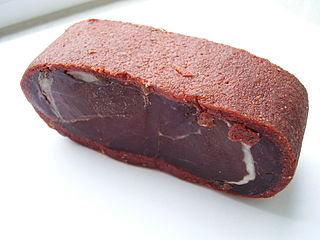 W
WPastırma or basturma, also called pastourma basdırma, as well as basterma, is a highly seasoned, air-dried cured beef that is part of the cuisines of Turkey, Macedonia, Iraq, Bulgaria, Greece, Azerbaijan and Armenia.
 W
WPastrami is a meat product of Romanian origin usually made from beef brisket, and sometimes from lamb, or turkey. The raw meat is brined, partially dried, seasoned with herbs and spices, then smoked and steamed. Beef plate is the traditional cut of meat for making pastrami, although it is now common in the United States to see it made from beef brisket, beef round, and turkey. Like corned beef, pastrami was originally created as a way to preserve meat before the invention of refrigeration.
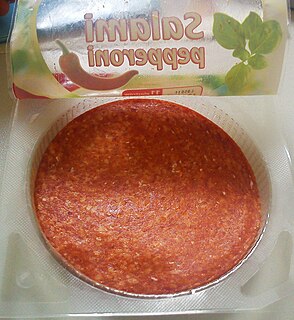 W
WPepperoni is an American variety of salami, made from a cured mixture of pork and beef seasoned with paprika or other chili pepper.
 W
WPitina, Peta or Petuccia is an Italian cold cut (salume) originating in the Dolomite valleys of Tramonti di Sopra and Tramonti di Sotto, and the River Cellina, in the northeastern Italian province of Pordenone in Friuli. It is not a true sausage, but a meatball made of smoked meats. The recipe was probably based on the impromptu need to preserve game. The preparation method did not require specialized equipment making it available to all homes, even the most isolated mountain huts.
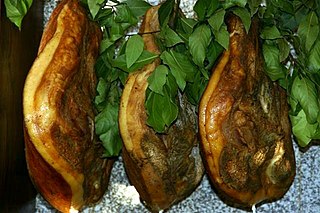 W
WPresunto is dry-cured ham from Portugal, similar to Spanish jamón or Italian prosciutto crudo.
 W
WRillettes is a preservation method similar to confit where meat is seasoned then slow cooked submerged in fat and cooked at an extremely slow rate for several hours. The meat is shredded and packed into sterile containers covered in fat. Rillettes are most commonly made with pork, but also made with other meats such as goose, duck, chicken, game birds, rabbit and sometimes with fish such as anchovies, tuna or salmon. Rillettes are best served at room temperature spread thickly on toasted bread.
 W
WRullepølse, also spelled rullepoelse or rullepolse, is a traditional Danish cold cut. A piece of pork belly—variants use beef flank or lamb—is flattened out and is spread with herbs and seasoning, chopped onions, and in some variants, parsley. It is then rolled up and placed in a brine for a number of days, before being placed in a special press, cooled, and sliced thinly. It is often use on rugbrød to make the traditional Danish open-faced sandwich, smørrebrød, usually garnished with a thick slice of sky and rings of raw onion.
 W
WSalami is a cured sausage consisting of fermented and air-dried meat, typically pork. Historically, salami was popular among Southern, Eastern, and Central European peasants because it can be stored at room temperature for up to 40 days once cut, supplementing a potentially meager or inconsistent supply of fresh meat. Countries and regions across Europe make their own traditional varieties of salami.
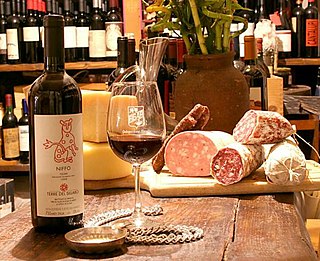 W
WSalumi is an Italian term describing the preparation of cured meat products made predominantly from pork. Salumi include bresaola, which is made from beef, and also cooked products such as mortadella and prosciutto cotto.
 W
WSmallgoods is a term used in New Zealand and Australia to refer to small meat products such as ham or pepperoni.
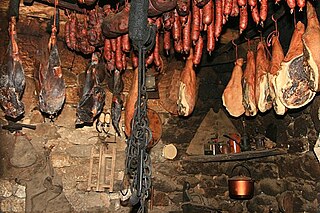 W
WSmoked meat is the result of a method of preparing red meat, white meat, and seafood which originated in the Paleolithic Era. Smoking adds flavor, improves the appearance of meat through the Maillard reaction, and combined with curing preserves the meat. When meat is cured then cold-smoked, the smoke adds phenols and other chemicals that have an antimicrobial effect on the meat. Hot smoking has less impact on preservation and is primarily used for taste and to slow-cook the meat. Interest in barbecue and smoking is on the rise worldwide.
 W
WVentricina is a pork sausage commonly found in the Abruzzo region of central Italy. It is similar to certain luncheon meats, included in the category English-speakers from the United States refer to as "cold cuts". It is traditionally made using relatively low grade, very fatty pig meat cuts and encasing them in the animal's intestines or stomach while they cure. There are two principal types of ventricina: those of the area in and around the city of Teramo, and others coming from the area of Vasto.